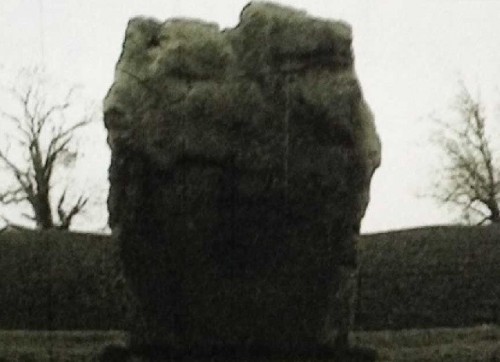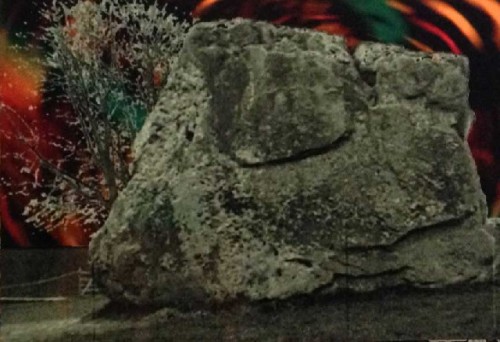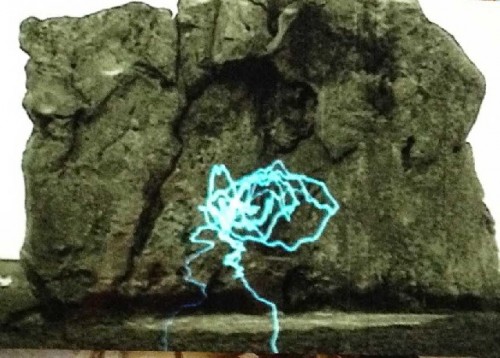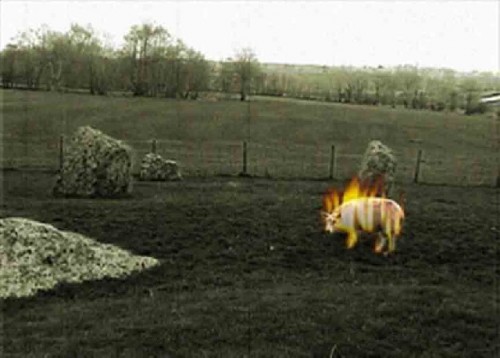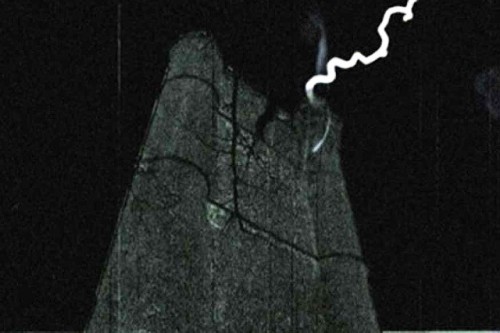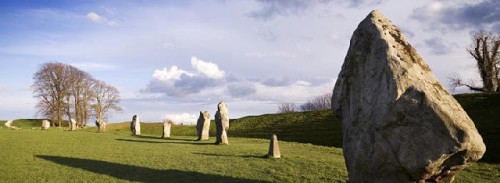Rethinking Stones an Exhibition and Video Project
Inspired by a 2000 Visit to Neolitihic Avebury in the U.K.
By: Jane Hudson and Charles Giuliano - Dec 28, 2013
Charles Giuliano Recently while in Ireland we visited the ancient preCeltic, Neolithic sites of Newgrange and a tomb in the Burren the rocky, lunar landscape. Previously we visited Stonehenge in England.
While in London we viewed an Ana Mendieta retrospective at Hayward Gallery.
Having just visited the ancient sites in Ireland, it was compelling to note a resonance with the Earth Goddess markings and site specific works of Mendieta. Clearly she was referencing the earliest humanistic, shamanic , ritual imagery in Western art. She also was influenced by the Santaria traditions of protoreligion in her native Cuba.
Yesterday I reread the chapters in the classic study Social History of Art by Arnold Hauser on the art of Paleolithic and Neolithic peoples. He contrasted the naturalism and pragmatic aspects of the hunter/ gatherer image makers of the Old Stone Age. Works which he compared to the horses of Degas were created with no religious impulse and purely as "magic" to ensure the success of the hunt. He described the more schematic, pictographic, conceptual, storytelling imagery of the New Stone Age with the first aspects of farming, raising animals and forming of social communities.
Exposure to these ancient sites and the Mendieta show connected with the exhibition Stones that I curated with you some years ago for the gallery of the New England School of Art and Design at Suffolk University. This recent travel and research raises fresh questions about that project.
How did you become interested in those ancient sites? During an exhibition of Celtic Art some years ago in Frankfurt, we learned that there were Celtic peoples and sites all over Europe. Most people have little awareness of the monuments beyond Stonehenge. Through Viking voyages to North America, there are solstice-oriented rock monuments in places where they visited.
Back when we were working on the exhibition, I recall that you discussed researching and visiting a number of sites in Ireland and England. You were given some support for the project as a faculty member of the School of the Museum of Fine Arts.
Jane Hudson Ever since I was a little girl, watching a blinking blue light on the radio tower of the police station next to my grandparents' home, I have wondered about the relationship between things cosmic and things earthly. I felt then that I had a special connection to information coming from ethereal places. Childish fantasies, no doubt, but the essential message, beyond that of formal religion, remains.
What is our relationship to the cosmos as earthlings?
In my twenties, I traveled to Mexico and visited some of the temples in the Yucatan, Chican Itsa, Palenque, Uxmal. Some archeological work had been done especially to Chican, but there was still a lot of rain forest around the other sites. I was touched by the bird-like Maya, and thought a lot about the powerful forces that brought their ancestors to build these edifices for ritual connection to the great mysteries.
Later, in another phase of life, I traveled to Ireland with some friends, and visited the Burren as well as the beehive fortifications on the coast of Kerry in Ireland. Again the impulse to erect monuments or divination artifacts or observatories to track the seasons, seemed profoundly familiar to me, as if I had understood it all along.
At another point, I was employed by a Classics professor to shoot video of some ancient sites on Sardinia--Nurage to be exact. These are circular stone structures, built in the Iron Age, their exact function not currently defined, but suggesting ritual and security functions.
Finally, I was given a grant to shoot video of Neolithic sites in Britain. These are, of course, the penultimate prehistoric monuments of Western culture. Stonehenge (now a tourist site of ridiculous proportions) and the more magnificent Avebury in the Salisbury Plain.
Avebury was the largest circle complex in ancient Britain covering many acres, and was ultimately bisected by the encroaching Christians. These huge stones defined the epicenter of the Old Religion's practices. What strikes me in the end is the connection all these places had to the Earth and its energies. This was a grounded impulse, a chthonic one.
CG You slip in but do not define the word chthonic. It was new to me so here is a definition.
“Chthonic (or from Greek χθÏŒνιος – chthonios, "in, under, or beneath the earth", from χθÏŽν – chthÅn "earth"; pertaining to the Earth; earthy; subterranean), apart from its literal translation meaning 'subterranean', its historical or interpretive definition designates, or pertains to, deities or spirits of the underworld, especially in relation to Greek religion.”
So let's try to understand what you are referencing.
As I understand from your travels you discuss encountering examples of ancient cultures that related to the earth (i.e. earth mother, fertility cults, and a subterranean spirit world) as well as creating large earth work figurations than can only be "read" from space. On ground level they are incomprehensible.
In the beginning I referred to Arnold Hauser's distinctions between the naturalism and magic of Paleolithic imagery vs. the pictographic, shamanistic animism and beginnings of a hierarchy of deities that informed the Neolithic cultures.
Perhaps you might connect the dots of your visits to ancient sites. What is the commonality of peoples all over the world in a developmental stage of understanding the natural world as well probing into a spiritual realm?
There seems to be a time line, plus or minus millennia, when diverse cultures engage in architectural monumentality. It is common, for example, to learn that Stonehenge or Newgrange are so many millennia before or after the Pyramids of Giza circa 2,500 BC. The inference is that different cultures are reaching similar conclusions or mandates before and after the Pyramids of Old Kingdom Egypt.
The Pyramids are the most familiar benchmark of monumental spiritual structures. Studies and calculations suggest that the layout of the pyramid field of Giza, passageways and burial chambers within the Great Pyramid, are oriented to celestial points visible over Egypt at that time. Specifically constellations identified with gods.
It implies an archetypal commonality to the human psyche which was a basic aspect of Jungian theory. We are more inclined to look at the human race for its diversity (for example the PC mantra of cultural diversity) rather than to assume a primal commonality of the human condition.
What were you thinking when you visited the Burren in Ireland with its rough Neolithic tombs and ritual sites? You have also mentioned seeing many hive-like structures in Kerry which served as shelters, fortifications and centers of rituals.
JH Let's say that 'stone' is the first manifestation of the human impulse to mark, to protect, to build as in fortifications against natural and human enemies, monuments to ancestors, and ultimately as temples to the gods. These gestures are meant to sustain 'forever', to preserve an ethnic heritage, a geographic territory and a spiritual aspiration.
(We might consider contemporary building practices where faux stone surfaces are affixed to very temporary steel and glass structures. It certainly says something about our sense of durability on this very fragile planet.)
My use of 'chthonic' is central to my identification with the sites I've encountered as well as with many of the images I identify in my video and photo work as well as in my lyrics and poetry. I mean it as coming from the body of the earth, from subterranean psychological, emotional and physical places. It is of the land, of deep history, of belief, of wonder, of doubt. It is profoundly philosophical in that it asks the most basic questions about the nature of life and death. It is about response, interaction, the tension of real encounter.
Oddly, when I visited the Burren, I was quite sick with a deep chest infection and feeling as if possessed by a very intractable parasite. So every place I came to had something fiercely defensive about it. The remains of old cottages devastated during the famine, the ruins of the beehive encampments, even the tombs had such a desperate quality to them, a savage ultimatum of natural and man-made cycles.
I had read Marija Gimbutas' work on the European 'Old Religion', the Mother Goddess worship that was so very earth bound. She makes a case for the feminine deity as manifest in Nature. She was quite influential in new age feminism. I was also practicing some Wiccan rituals with a friend who later accompanied me to England. That's another story!
I used The Modern Antiquarian by Julian Cope as a guide to the sites we visited. He had been a member of The Teardrop Explodes, a British rock group and later spent his time researching the Neolithic monuments of Britain.
Cope traveled widely in Britain to find many obscure sites, some of which are in fact located on active farms. One such place was filled with grazing sheep that I had to dodge while trying to shoot video. Another site was simply by a roadside. So many we caught by chance or by trying to navigate Cope's directions. The grandeur of Avebury, however, was the most impactful of all. The scale and symmetry of the circle, the entry trackway, and the not so subtle presence of the town made it perfect for my purposes.
It should be said that Stonehenge, which was constructed later than Avebury, is still so familiar as to be thrilling upon approach. But it is disappointing to see bus loads of people trek around the monument (one cannot walk within it) as if passing a body lying in state. It's a ritual experience much like seeing the Mona Lisa but has little to do with the gravitas that the site embodies.
CG There is an initial impact when we visit these sites. Then a lingering gestation and thinking process which lingers long after. In your case how did the Irish experience lead to developing the later project of Avebury in Great Britain?
What is the time frame for when you visited Ireland and then Great Britain? You have mentioned that it was around 2000.
JH I went to Ireland in 1998 and then to England in 2000.
CG In what way did the Irish experience inform writing a travel/ research proposal for the Museum School? How did you evolve to the decision to create a fine arts project out of visiting the sites?
JH The Museum School offers annual Faculty Enrichment Grants, and I formulated the project to fit within their guidelines. Having traveled to Sardinia in the late '80s to shoot video of the Nurage, I was open to trekking to sites. The technology had evolved to DV, which is quite small, and all the more portable. Also Video had become more of an installation/projection medium in the gallery context. I wanted to develop a piece for that option. The stones seemed to me to have a kind of Modernist simplicity and sculptural integrity that fit with contemporary aesthetics and technology.
CG When we first discussed the project as an exhibition for the Gallery of the New England School of Art and Design you were involved in the process of editing video material. Also you created large graphics for the show. It surprised me that you didn’t take photographs.
JH Actually there may have been some pics around but I never shot any. Remember there were no smart phone cameras then, and posting images was a big deal. I was in process of editing the series, TRIlOGY (available to see on the Website <officialjeffandjane.com>)
Using the "look" of old film to denote a historicity, the artist constructs an imperiled landscape which resonates like a ghostly dream. The works explore the poetics of the "natural" as an idea that obscures the sublimation of its effects. (Quote from the site)
CG What kind of video cameras and editing programs were you working with at the time?
JH The series was shot on a Canon DV camcorder, and edited in FinalCut Pro, Adobe AfterEffects and Flash.
CG Describe how you developed the exhibition from the raw material?
JH The show at New England School of Art (your show) was comprised of about 10 large scale prints (about 5x4') grabbed from the video. Again, using tiff files to print from was a fairly young process, and had to be done by an industrial printer. There were many snags along the way, especially in the mounting.
CG At the time you spoke to me about wanting to project the images at the full scale of the actual stones. Given the dimensions of the gallery that was not possible.
JH Yes, that would have been ideal, but as you say, the gallery space didn't allow for it. Plus, I was unable to secure a projector. At that time they were few and far between, and quite expensive.
CG When we talked about the work recently you said that none of it has survived. At least the large graphic pieces are now lost. I assumed you have the video files in what must now be obsolete programs. That’s the general problem of ever developing media.
JH I do have the video files, and as they are in Mac QuickTime format, they are still viable. As to the prints, there has been too much moving in my life in recent years to allow for keeping lots of works. Physical space is limited.
CG Can you discuss peer and critical reception for the work? It seems that the NESA&D show was the only exhibition of the work.
JH Cate McQuaid of the Boston Globe did review the show, and was mixed in her opinion. Some colleagues liked it, but it had a limited audience. I did come quite close to being included in the Whitney Biennial but didn't make the cut. Parts of the series were screened in a Hong Kong Biennial and the Ann Arbor Film Festival. Also at the Museum School.
CG Of course hindsight is 20/20 and today one assumes there would be more interest in the imagery and source material. Ten years ago when we showed the work, for example, there was no video program at NESA&D so there was limited student and faculty interest. But one would like to think it was different for the Museum School. Is there any way that you might come back to this material?
JH I will always love this work. It really captured something deeply personal to me, a kind of cosmic connection. In my recent CD Links and Bridges, the songs “Make It So” and “The Place” are directly connected to the imagery and sentiments.
Yes, as I said, the material resonates with me. I have tattoos of places I've been that have power or images that speak of that old chthonic connection. My latest is a Crow! In my neighborhood there is a murder of crows who come to my call for bread, and who speak to me when I'm out with the dog. They are my local connection to the heartbeat of the place and to my aging in it.
Lots of info is available on the officialjeffandjane.com pages. Look especially at 'Jane Hudson's Page.'



